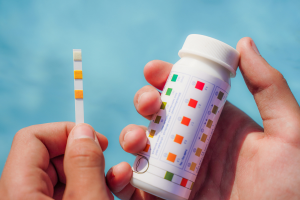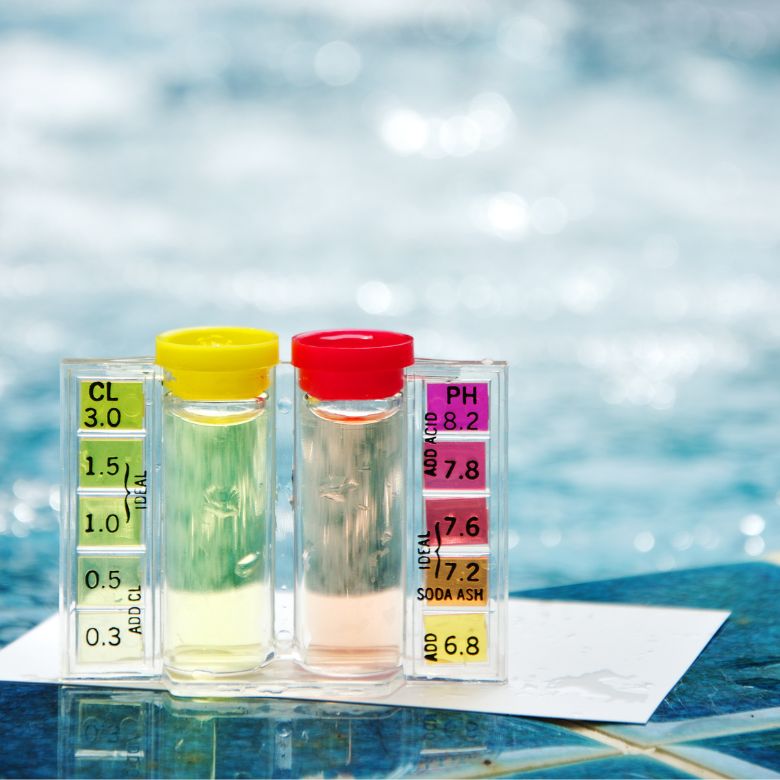Chlorinating pool water is the most effective way to quickly disinfect your swimming pool. Chlorine eliminates bacteria and fungi, ensuring that water keeps its nice colour and neutral smell. However, the routine process of shock chlorination or cyclic chlorination should always be carried out carefully and with caution. When to add chlorine to the pool? How much chlorine should be added at once? Here are the answers!

When to add chlorine to the pool?
Anyone who has a garden pool or a year-round swimming pool knows how quickly microorganisms can multiply inside it. The artificial reservoir affected by heat, light and contaminants turns into a breeding site for pathogenic microbes in a couple of days. How to inhibit decomposition and when to add chlorine to the pool? You should carry out disinfection immediately if:
- the water has changed its colour or smell,
- the pool was used by several people for many hours,
- you have filled it for the first time,
- organic pollutants (leaves, grass dead skin, etc.) have entered the water,
- the outside temperature exceeds 30 °C.
When to add chlorine to the pool? You should do it when there is nobody in the water. In summer, you should perform chlorination at least once a week. If the pool is small and used frequently, consider buying a dosing buoy. Such a light plastic floater regularly doses chlorine into the water and should only be taken out of the water when someone goes into the pool.
How to calculate the required amount of chlorine?
When using chlorine, remember that if its amount is insufficient, it will not protect the water against the effects of decomposing organic matter. When the water contains too much chlorine, there is an increased risk of poisoning and pulmonary oedema. So how to calculate the proper dose of chlorine? The packages of speciality products include detailed recipes and recommended proportions of chlorine and water.
To be able to determine how much of a given chemical should be added to the pool, you should first ascertain the size of the pool. You should also pay attention to the condition of the water: if it is highly contaminated or if shock chlorination has not been performed, you should increase the chlorine dose according to the instructions. Please also note that chlorine capsules, granules, and powder contain different amounts (dosages) of chlorine.
How much chlorine per m3 of pool water?
If you do not know how much chlorine to add to your pool, you should always follow the manufacturer’s instructions. The dose mainly depends on whether you plan shock chlorination or conventional maintenance chlorination. How many grams of chlorine per 1,000 litres of water should be added for shock chlorination? If you use chlorine in granules, you should add 5 g to 8 g of chlorine. For routine, regular maintenance, 3.5 g to 5 g of chlorine will be enough.
The packaging of disinfecting products always includes instructions on how many chlorine tablets should be used on a one-off or regular basis. These are often multi-purpose tablets that should be dosed at 1 piece per 1 cubic metre of water.
How much chlorine should be added to the pool: some practical tips
The proper dosing of chlorine is not easy, especially if you do it for the first time. Here are some frequently asked questions on how much chlorine for a garden pool is recommended by the manufacturers of pool chemicals:
- How to disinfect a 305 x 76 pool: how much chlorine should be added? It is enough to add 1–2 chlorine capsules per week.
- How much chlorine should be added to a 3,000 l pool? For standard maintenance of water, it is enough to add 30 g of granulate or 1 multi-purpose tablet once a week.
- How much chlorine should be added to a 5,000 l pool? If chlorination is carried out weekly, it is best to add 2 to 3 capsules per week, unless the manufacturer recommends otherwise. For shock chlorination, you can use 50 g of granulate (or even 100 g if the water is no longer clear).
As a garden pool owner, you should also know how to reduce chlorine in your pool and how to control the water pH level. In the following section of the article, we present some practical tips on how to care about pool water.

Chlorine dosing and pool water pH
To be able to determine the appropriate amount of chlorine, we should briefly analyse the water pH. How to analyse it? Just use a simple manual tester that indicates both the pH and the chlorine content. Remember that the proper pH level in the pool should be 7 to 7.4. When the water has a pH that is too alkaline or too acidic, the chlorine does not work properly (it might even not work at all). So what to use to regulate pH in a pool?
How to increase or reduce water pH in a pool?
How to reduce the water pH in a pool? To do this, you should use pH-minus formulations (in the form of powder, granules or liquid). They will help you achieve the maximum effectiveness of the chlorine. (Reducing the water pH in the pool also prevents the formation of lime deposits and clogging of the water filtering system).
How to increase the water pH in a pool? This is done by using pH-plus products in the form of powder or liquid. They are speciality chemicals that eliminate corrosion within the pool and remove the irritating odour of chlorine.
How to neutralise chlorine in a pool?
When checking the chlorine level in the pool water, it may turn out that its concentration exceeds the allowable limits. What to do then and how to remove chlorine from the pool water? You can do it by using products whose names include phrases such as ‘chlorine stop’ or ‘anti-chlorine’. They are usually sold as granules that are easily soluble in water.
How to reduce chlorine level in a pool? First you should measure out the appropriate amount of chlorine stop or anti-chlorine granulate and then prepare a receptacle filled with water. Pour the granulate into the water, dissolve it, and then pour it into the pool. After around 30 minutes, re-check the chlorine content; if the concentration is still too high, perform the procedure again.
Remember that one of the most effective preparations that lower the chlorine content in water is L-ascorbic acid (vitamin C). How to remove chlorine from a pool using this readily available, inexpensive product? Just pour around 50 g of the acid per cubic metre of water. Check the chlorine content after approximately 30 minutes. If the tester still indicates an incorrect value, redo the whole procedure.
Pool water chlorination: summary
In summer, when we use our home pools frequently, the water becomes a source of bacteria, fungi and algae. These pathogenic microorganisms pose a risk to our health and adversely affect the appearance of the pool. When we know how to dose our pool chemicals, reduce chlorine content in the pool and check the water pH, then we can keep the pool safe and clean. Proper chlorine dosage ensures that the water remains crystal clear and maintains its neutral smell.
What else should you know about pool chemicals? Are there any other methods for reducing chlorine concentration in a pool or change the water pH? Read our blog and find out.